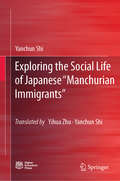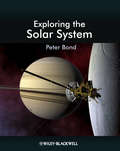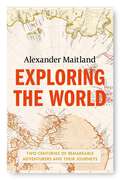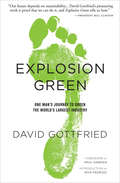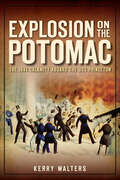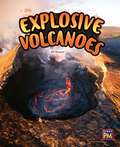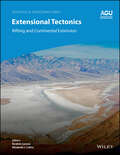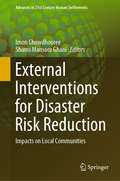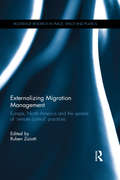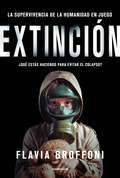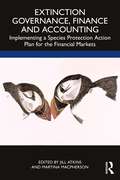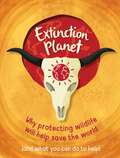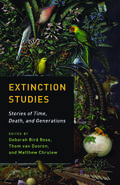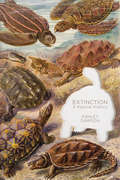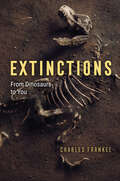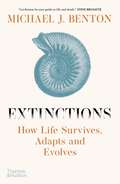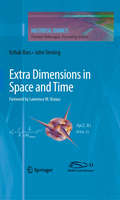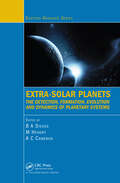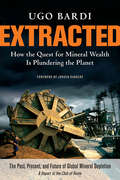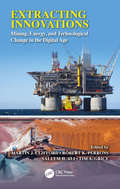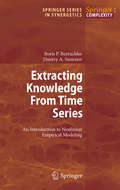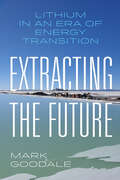- Table View
- List View
Exploring the Social Life of Japanese “Manchurian Immigrants”
by Yanchun ShiThe book studies the “Manchurian immigrants” from many important aspects suchas agricultural operation, education, religion, and women’s issues. It contains thefollowing features: first, readers can get deeper understanding on the “Manchurianimmigrants” policies by investigating the agriculture-based social life of the“Manchurian immigrants” in Northeast China; second, studying the life conditions ofthe “Manchurian immigrants” can make up for the lack of researches in related fieldto some extent; third, readers are given chances by this book to learn Japanese societyand Japanese people from another facet.
Exploring the Solar System (Coursesmart Ser.)
by Peter BondThe exploration of our solar system is one of humanity's greatest scientific achievements. The last fifty years in particular have seen huge steps forward in our understanding of the planets, the sun, and other objects in the solar system. Whilst planetary science is now a mature discipline - involving geoscientists, astronomers, physicists, and others – many profound mysteries remain, and there is indeed still the tantalizing possibility that we may find evidence of life on another planet in our system.Drawing upon the latest results from the second golden age of Solar System exploration, author Peter Bond provides an authoritative and up-to-date account of the planets, satellites and smaller debris that orbit the Sun. Written in an informal style, with minimal use of mathematics, this book is the ideal introductory text for non-science students and other readers with little or no science background. With the aid of numerous illustrations, many in full colour, this exciting book brings to life the weird and wonderful worlds that populate our corner of the Universe. This book: Assumes no background in physics , astronomy or mathematics Carefully explains key concepts Gives balanced coverage to areas of controversy or uncertainty in planetary science Is in in full color throughout and richly illustrated An interview with Peter can be found at http://wisciblog.com/2012/02/28/exploring-the-solar-system/
Exploring the World: Two centuries of remarkable adventurers and their journeys
by Alexander MaitlandExplorers and travellers have always been attracted by the lure of the unknown. By traversing and mapping our planet, they have played a vital role in mankind's development. For almost two hundred years, the Royal Geographical Society has recognised their achievements by awarding its prestigious gold medals to those who have contributed most to our knowledge of the world.Taking us on a journey across mountains and deserts, oceans and seas, Exploring the World tells the stories of more than eighty of these extraordinary men and women. Some, such as David Livingstone, Scott of the Antarctic and Jacques-Yves Cousteau, are well known; whilst others, such as William Chandless and Ney Elias, are today less familiar. Some dreamed of being the first to sight a lake or a river; others sighted some of the world's greatest natural features by chance. Some were naturalists, anthropologists or mountaineers; others went in search of explorers who had vanished without trace, or had been shipwrecked or marooned.Filled with epic tales of endurance and perseverance, Exploring the World celebrates a group of exceptional individuals possessed of indomitable courage, boundless determination and adventurous spirit. It portrays a variety of fascinating lives driven by curiosity, wanderlust and the pursuit of knowledge - and, in doing so, provides a unique overview of two centuries of exploration.
Explosion Green: One Man's Journey to Green the World's Largest Industry
by David GottfriedThe inspiring true account of one man&’s successful mission to bring sustainability into the building industry around the world. The winner of three Indie Book Awards, Explosion Green tells the twenty-year story of the global green building movement through the eyes of David Gottfried, the man who helped start it all. Explosion Green reveals the inner workings of the building industry as it comes to grips with the need for environmentally friendly practices. It describes how the industry has evolved, and how this evolution has helped fight climate change and prevent further damage to the environment while creating a multibillion-dollar industry. Filled with his unique insight and self-deprecating humor, Gottfried&’s riveting memoir demonstrates how one person can start a global movement. &“Our future depends on sustainability . . . David Gottfried&’s pioneering work is proof that we can do it, and Explosion Green tells us how.&” —President Bill Clinton &“Transformation of the most important sector in the nation&’s energy economy resulted from David Gottfried&’s pioneering work. Students and professionals will be inspired by this book as it describes the pathway that led to such monumental results.&” —Gil Masters, Professor Emeritus of Civil and Environmental Engineering, Stanford University &“David inspires us to believe we have the ability to envision a future that we might create. He has lived it firsthand and generously shares his learning with us.&” —Maria Atkinson Am, Cofounder, Green Building Council of Australia
Explosion on the Potomac: The 1844 Calamity Aboard the USS Princeton (Disaster Ser.)
by Kerry WaltersIn 1844, the USS "Princeton" was the most technologically sophisticated warship in the world. Its captain, Robert Stockton, and President John Tyler were both zealous expansionists, and they hoped that it would be the forerunner in a formidable steam-powered fleet. On a Potomac cruise intended to impress power brokers, the ship's main gun--the Peacemaker--exploded as the vessel neared Mount Vernon. Eight died horribly, while twenty others were injured. Two of Tyler's most important cabinet members were instantly lost, and the president himself had a near miss--making it the worst physical disaster to befall a presidential administration. The tragedy set off an unpredictable wave of events that cost Tyler a second term, nearly scuttled plans to add Texas to the Union and stirred up sectional rancor that drove the nation closer to civil war. Author Kerry Walters chronicles this little-known disaster that altered the course of the nation's history.
Explosions in Underground Coal Mines: Risk Assessment And Control
by Jianwei ChengThis book addresses the hazard of gas explosions in sealed underground coal mines, and how the risk of explosion can be assessed, modeled, and mitigated. With this text, coal mine operators and managers will be able to identify the risks that lead to underground mine gas explosions, and implement practical strategies to optimize mining safety for workers. In six chapters, the book offers a framework for understanding the sealed coal mine atmosphere, the safety characteristics that are currently in place, and the guidelines to be followed by engineers to improve upon these characteristics. The first part of the book describes the importance and characteristics of underground gas mine explosions in a historical context with data showing the high number of fatalities from explosion incidents, and how risk has been mitigated in the past. Chapters also detail mathematical models and explosibility diagrams for determining and understanding the risk factors involved in mine explosions. Readers will also learn about safety operations, and assessments for the sealed mine atmosphere. With descriptions of chapter case studies, mining engineers and researchers will learn how to apply safety measures in underground coal mines to improve mining atmospheres and save lives.
Extensional Tectonics: Rifting and Continental Extension (Geophysical Monograph Series #278)
by Elizabeth J. Catlos İbrahim ÇemenA synthesis of current knowledge on global extensional tectonics The extension of Earth’s lithosphere occurs at divergent plate boundaries as well as in plate interiors. The geological, geochemical, and sedimentary processes of extension offer insights into topics ranging from the fundamentals of tectonics to the evolution of life. Extensional Tectonics: Rifting and Continental Extension reviews present-day knowledge of extensional tectonic processes and explores examples from around the world. Volume highlights include: Overview of extensional tectonic processes from continental rifting to oceanic basin formation In-depth examination of extension along rift systems and rift margins Review of post-collisional continental extension Examples from Africa, Asia, Europe, and the Americas Insights from observations, modeling, and 3D seismic data interpretation of extended terrains This book is one of a set of three in the collection Tectonic Processes: A Global View.Browse the first volume, Compressional Tectonics: Plate Convergence to Mountain Building. The American Geophysical Union promotes discovery in Earth and space science for the benefit of humanity. Its publications disseminate scientific knowledge and provide resources for researchers, students, and professionals.
External Interventions for Disaster Risk Reduction: Impacts on Local Communities (Advances in 21st Century Human Settlements)
by Imon Chowdhooree Shams Mansoor GhaniThis book presents a case study-based analysis of the consequences of external interventions, critically evaluating them from community perspectives. Communities – from rural to urban, and around the world – that are experiencing disasters and changes in climatic variables can perceive the associated risks and evaluate the impacts of interventions. Accordingly, community perspectives, including their perceptions, concerns, awareness, realizations, reactions and expectations, represent a valuable resource. The case-based analysis of impacts on communities can provide a ‘means of learning’ from the experiences of others, thus expanding professionals’ knowledge base, especially regarding disaster mitigation and climate change adaptation practices in varied settings. This book offers valuable insights and lessons learned, in an effort to promote and guide innovative changes in the current planning, management and governance of human settlements, helping them face the future challenges of a changing environment.
Externalizing Migration Management: Europe, North America and the spread of 'remote control' practices (Routledge Research in Place, Space and Politics)
by Ruben ZaiottiThe extension of border controls beyond a country’s territory to regulate the flows of migrants before they arrive has become a popular and highly controversial policy practice. Today, remote control policies are more visible, complex and widespread than ever before, raising various ethical, political and legal issues for the governments promoting them. The book examines the externalization of migration control from an interdisciplinary and comparative perspective, focusing on ‘remote control’ initiatives in Europe and North America, with contributions from the fields of politics, sociology, law, geography, anthropology, and history. This book uses empirically rich analyses and compelling theoretical insights to trace the evolution of ‘remote control’ initiatives and assesses their impact and policy implications. It also explores competing theoretical models that might explain their emergence and diffusion. Individual chapters tackle some of the most puzzling questions underlying remote control policies, such as the reasons why governments adopt these policies and what might be their impact on migrants and other actors involved.
Extinción: La supervivencia de la humanidad en juego. / ¿Qué estás haciendo para evitar el colapso?
by Flavia BroffoniLa información sobre la crisis ecológica y climática está al alcance de todos y en boca de nadie. Extinción nos revela toda la información que no sale en los medios hegemónicos de comunicación, y pone en evidencia la crisis planetaria en que nos encontramos. Este es un libro urgente para entender qué hay detrás de esta crisis. Desde las estrategias políticas, el agronegocio y los modelos educativos hasta las formas de consumo que nos parecen naturales, este libro cuenta con la fuerza suficiente para hacernos ver la realidad y comenzar a actuar conscientemente. Extinción nos revela con evidencia científica la crisis ecológica y climática que atraviesa nuestro planeta. En los próximos cincuenta años 4000 millones de personas vivirán en zonas no aptas para la producción de alimentos. Para 2080 América del Sur estará en una sequía extrema. El 60% de los mamíferos y el 70% de las aves son criados para alimentar humanos. Este año una pandemia puso en estado de emergencia a todo el mundo. El 60% de las enfermedades infecciosas son transmitidas por animales. Mientras, crece la población de animales industrializados en hábitats naturales destruidos y ecosistemas alterados. ¿Qué estamos haciendo para frenar este ecocidio? ¿Por qué esta información no está al alcance de todos? Flavia Broffoni propone darle batalla a la civilización que está arrasando con la naturaleza. Extinción es un libro urgente: quedan menos de diez años para detener el colapso. En palabras de la autora, "la decisión más honesta que podemos tomar en estos momentos de incertidumbre es qué hacer con el Tiempo que tenemos".
Extinction Governance, Finance and Accounting: Implementing a Species Protection Action Plan for the Financial Markets
by Jill AtkinsThe planet is currently experiencing a mass extinction event, with human and business activity being the root cause of species loss and habitat destruction. Industries, companies, banks, investors, accountants and auditors have all played their role. This book explores how they can also provide a solution. The book presents plans, metrics, frameworks, mechanisms and financial innovations that can be, and are being, implemented through the financial markets in order to save and protect species, enhance biodiversity and, at the same time, preserve the financial markets and the business world. This biodiversity handbook addresses the intersection between species extinction and the global capitalist system. With contributions from leading non-governmental organisations such as the Capitals Coalition, Business for Nature, the Ecojustice Foundation, ShareAction and the Endangered Wildlife Trust, plus senior researchers in the field, as well as industry experts from Moody’s, EOS at Hermes Federated Investment Management, BlueBay Asset Management, ODDO BHF Asset Management and OSSIAM (to mention just a few), this book is at the forefront of addressing the crucially important topics of extinction accounting, finance and governance. Drawing on leading research, the book is written in an accessible style and is relevant to researchers and students in the fields of sustainability, governance, accounting, finance, corporate social responsibility and corporate governance. It is essential reading for investors, responsible investors, bankers, business leaders and policy makers in the field of sustainable financial markets. Given the interdisciplinary nature of this book, it is useful to conservationists, ecologists and others involved in species and biodiversity protection.
Extinction Planet
by Anna ClaybourneExtinction Planet offers young readers a clear, insightful look at Earth's wildlife extinction crisisIt is estimated that out of around eight million species on Earth, at least one million plant and animal species are threatened with extinction, and that the current rate of extinction is up to 100 times higher than in any previous mass extinction. And it's human activity that's largely responsible for this frightening decline.Extinction Planet takes a non-alarmist, but truthful, look at Earth's extinction crisis, explaining what a mass extinction is, how they occur and what their repercussions can be. It explores how, as humankind has caused this latest biodiversity crisis, we also have the solutions to slow or stop its damage, from reining in overconsumption, rewilding natural places, making farming more planet-friendly, preventing overfishing and seriously tackling climate change. It also suggests ways we can all live in a more planet-friendly way, from global changes such as investing in renewable energy sources, to individual actions such as buying sustainable products and eating less meat and fish.Following on from Plastic Planet, Hot Planet, Recycled Planet and Sustainable Planet, Extinction Planet features the same blend of illustrations and photos and a striking cover, and is written by the award-winning author Anna Claybourne.Aimed at readers aged 9 and up.
Extinction Studies: Stories of Time, Death, and Generations
by Thom Van Dooren Edited by Deborah Bird Rose Matthew ChrulewExtinction Studies focuses on the entangled ecological and social dimensions of extinction, exploring the ways in which extinction catastrophically interrupts life-giving processes of time, death, and generations. The volume opens up important philosophical questions about our place in, and obligations to, a more-than-human world. Drawing on fieldwork, philosophy, literature, history, and a range of other perspectives, each of the chapters in this book tells a unique extinction story that explores what extinction is, what it means, why it matters—and to whom.
Extinction and Memorial Culture: Reckoning with Species Loss in the Anthropocene
by Hannah StarkThis book considers how we encounter and make meaning from extinction in diverse settings and cultures. It brings together an international and interdisciplinary range of scholars to consider how extinction is memorialised in museums and cultural institutions, through monuments, in literature and art, through public acts of ritual and protest, and in everyday practices. In an era in which species are becoming extinct at an unprecedented rate, we must find new ways to engage critically, creatively, and courageously with species loss. Extinction and Memorial Culture: Reckoning with Species Loss in the Anthropocene develops the conceptual tools to think in complex ways about extinctions and their aftermath, along with providing new insights into commemorating and mourning more-than-human lives. This book will be of great interest to students and scholars of the environmental humanities, extinction studies, memorial culture, and the Anthropocene.
Extinction: A Radical History
by Ashley DawsonSome thousands of years ago, the world was home to an immense variety of large mammals. From wooly mammoths and saber-toothed tigers to giant ground sloths and armadillos the size of automobiles, these spectacular creatures roamed freely. Then human beings arrived. Devouring their way down the food chain as they spread across the planet, they began a process of voracious extinction that has continued to the present.Headlines today are made by the existential threat confronting remaining large animals such as rhinos and pandas. But the devastation summoned by humans extends to humbler realms of creatures including beetles, bats and butterflies. Researchers generally agree that the current extinction rate is nothing short of catastrophic. Currently the earth is losing about a hundred species every day.This relentless extinction, Ashley Dawson contends in a primer that combines vast scope with elegant precision, is the product of a global attack on the commons, the great trove of air, water, plants and creatures, as well as collectively created cultural forms such as language, that have been regarded traditionally as the inheritance of humanity as a whole.This attack has its genesis in the need for capital to expand relentlessly into all spheres of life. Extinction, Dawson argues, cannot be understood in isolation from a critique of our economic system. To achieve this we need to transgress the boundaries between science, environmentalism and radical politics. Extinction: A Radical History performs this task with both brio and brilliance.
Extinctions: From Dinosaurs to You
by Charles FrankelA compelling answer to an important question: Can past mass extinctions teach us how to avoid future planetary disaster? On its face, the story of mass extinction on Earth is one of unavoidable disaster. Asteroid smashes into planet; goodbye dinosaurs. Planetwide crises seem to be beyond our ability to affect or evade. Extinctions argues that geological history tells an instructive story, one that offers important signs for us to consider. When the asteroid struck, Charles Frankel explains, it set off a wave of cataclysms that wore away at the global ecosystem until it all fell apart. What if there had been a way to slow or even turn back these tides? Frankel believes that the answer to this question holds the key to human survival. Human history, from the massacre of Ice Age megafauna to today’s industrial climate change, has brought the planet through another series of cataclysmic events. But the history of mass extinction together with the latest climate research, Frankel maintains, shows us a way out. If we curb our destructive habits, particularly our drive to kill and consume other species, and work instead to conserve what biodiversity remains, the Earth might yet recover. Rather than await decisive disaster, Frankel argues that we must instead take action to reimagine what it means to be human. As he eloquently explains, geological history reminds us that life is not eternal; we can disappear, or we can become something new and continue our evolutionary adventure.
Extinctions: How Life Survives, Adapts And Evolves
by Michael J. BentonA journey through the great mass extinction events that have shaped our Earth. This timely and original book lays out the latest scientific understanding of mass extinction on our planet. Cutting-edge techniques across biology, chemistry, physics, and geology have transformed our understanding of the deep past, including the discovery of a previously unknown mass extinction. This compelling evidence, revealing a series of environmental crises resulting in the near collapse of life on Earth, illuminates our current dilemmas in exquisite detail. Beginning with the oldest, Professor Michael J. Benton takes us through the “big five” die outs: the Late Ordovician, which set the evolution of the first animals on an entirely new course; the Late Devonian, apparently brought on by global warming; the cataclysmic End-Permian, also known as the Great Dying, which wiped out over 90 percent of alllife on Earth; the newly discovered Carnian Pluvial Event; and the End-Cretaceous asteroid. He examines how global warming, acid rain, ocean acidification, erupting volcanoes, and meteorite impact have affected conditions on Earth, and how life survived, adapted, and evolved. Benton’s expert retelling of scientific breakthroughs in paleobiology is illustrated throughout with photographs of fossils and fieldwork, and artistic reconstructions of ancient environments. In Extinctions, readers will learn about revolutionary new tools used to uncover ancient extinction events and processes in forensic detail, and how scientists are improving our understanding of the deep past. New research allows us to link long-ago upheavals to crises in our current age, the Anthropocene, with important consequences for us all.
Extra Dimensions in Space and Time
by Lawrence Krauss John Terning Farzad Nekoogar Itzhak BarsIn physics, the idea of extra spatial dimensions originates from Nordstöm's 5-dimensional vector theory in 1914, followed by Kaluza-Klein theory in 1921, in an effort to unify general relativity and electromagnetism in a 5 dimensional space-time (4 dimensions for space and 1 for time). Kaluza-Klein theory didn't generate enough interest with physicist for the next five decades, due to its problems with inconsistencies. With the advent of supergravity theory (the theory that unifies general relativity and supersymmetry theories) in late 1970's and eventually, string theories (1980s) and M-theory (1990s), the dimensions of space-time increased to 11 (10-space and 1-time dimension). There are two main features in this book that differentiates it from other books written about extra dimensions: The first feature is the coverage of extra dimensions in time (Two Time physics), which has not been covered in earlier books about extra dimensions. All other books mainly cover extra spatial dimensions. The second feature deals with level of presentation. The material is presented in a non-technical language followed by additional sections (in the form of appendices or footnotes) that explain the basic equations and formulas in the theories. This feature is very attractive to readers who want to find out more about the theories involved beyond the basic description for a layperson. The text is designed for scientifically literate non-specialists who want to know the latest discoveries in theoretical physics in a non-technical language. Readers with basic undergraduate background in modern physics and quantum mechanics can easily understand the technical sections. Part I starts with an overview of the Standard Model of particles and forces, notions of Einstein's special and general relativity, and the overall view of the universe from the Big Bang to the present epoch, and covers Two-Time physics. 2T-physics has worked correctly at all scales of physics, both macroscopic and microscopic, for which there is experimental data so far. In addition to revealing hidden information even in familiar "everyday" physics, it also makes testable predictions in lesser known physics regimes that could be analyzed at the energy scales of the Large Hadron Collider at CERN or in cosmological observations." Part II of the book is focused on extra dimensions of space. It covers the following topics: The Popular View of Extra Dimensions, Einstein and the Fourth Dimension, Traditional Extra Dimensions, Einstein's Gravity, The Theory Formerly Known as String, Warped Extra Dimensions, and How Do We Look For Extra Dimensions?
Extra-Solar Planets: The Detection, Formation, Evolution and Dynamics of Planetary Systems
by B A Steves M Hendry A C CameronSince the discovery of the first exoplanet orbiting a main sequence star in 1995, nearly 500 planets have been detected, with this number expected to increase dramatically as new ground-based planetary searches begin to report their results. Emerging techniques offer the tantalizing possibility of detecting an Earth-mass planet in the habitable zon
Extracted
by Jorgen Randers Ugo BardiAs we dig, drill, and excavate to unearth the planet's mineral bounty, the resources we exploit from ores, veins, seams, and wells are gradually becoming exhausted. Mineral treasures that took millions, or even billions, of years to form are now being squandered in just centuries-or sometimes just decades. Will there come a time when we actually run out of minerals? Debates already soar over how we are going to obtain energy without oil, coal, and gas. But what about the other mineral losses we face? Without metals, and semiconductors, how are we going to keep our industrial system running? Without mineral fertilizers and fuels, how are we going to produce the food we need?Ugo Bardi delivers a sweeping history of the mining industry, starting with its humble beginning when our early ancestors started digging underground to find the stones they needed for their tools. He traces the links between mineral riches and empires, wars, and civilizations, and shows how mining in its various forms came to be one of the largest global industries. He also illustrates how the gigantic mining machine is now starting to show signs of difficulties. The easy mineral resources, the least expensive to extract and process, have been mostly exploited and depleted. There are plenty of minerals left to extract, but at higher costs and with increasing difficulties.The effects of depletion take different forms and one may be the economic crisis that is gripping the world system. And depletion is not the only problem. Mining has a dark side-pollution-that takes many forms and delivers many consequences, including climate change. The world we have been accustomed to, so far, was based on cheap mineral resources and on the ability of the ecosystem to absorb pollution without generating damage to human beings. Both conditions are rapidly disappearing. Having thoroughly plundered planet Earth, we are entering a new world. Bardi draws upon the world's leading minerals experts to offer a compelling glimpse into that new world ahead.
Extracting Innovations: Mining, Energy, and Technological Change in the Digital Age
by Martin J. Clifford, Robert K. Perrons, Saleem H. Ali and Tim A. GriceThis book considers the most contemporary innovations propelling the extractive industries forward while also creating new environmental and social challenges. The socio-ecological fabric of innovation in the extractive industries is considered through an integrative approach that brings together engineers, natural scientists, and social scientists—academics and practitioners—giving an empirically grounded and realistic evaluation of the innovations in this sector. It synthesizes a series of questions including:
Extracting Knowledge From Time Series: An Introduction to Nonlinear Empirical Modeling
by Boris P. Bezruchko Dmitry A. SmirnovThis book addresses the fundamental question of how to construct mathematical models for the evolution of dynamical systems from experimentally-obtained time series. It places emphasis on chaotic signals and nonlinear modeling and discusses different approaches to the forecast of future system evolution. In particular, it teaches readers how to construct difference and differential model equations depending on the amount of a priori information that is available on the system in addition to the experimental data sets. This book will benefit graduate students and researchers from all natural sciences who seek a self-contained and thorough introduction to this subject.
Extracting the Future: Lithium in an Era of Energy Transition
by Mark GoodaleBolivia's troubled efforts to develop a commercial lithium industry. Bolivia's lithium accounts for a significant percentage of the world's known reserve. Drawing on extensive ethnographic research, Mark Goodale traces the development of Bolivia's closely guarded lithium project through the perspectives of a wide array of people and institutions, including workers at the Salar de Uyuni, the world's largest salt flat; the state lithium company in La Paz; Latin America's first electric vehicle company; and energy entrepreneurs in Bolivia, the United States, and Germany. He points to a fundamental contradiction: a so-called green energy transition dependent on the ever-greater extraction of yet another nonrenewable resource. But without access to Bolivia's lithium, and at megaindustrial scales that far outstrip current production, there won't be sufficient lithium supply to make the batteries needed for a truly global EV revolution. Extracting the Future shows how the lithium economy is deeply embedded in a global capitalist system that continues to rely on resource extraction, unsustainable economic growth, and geopolitical violence.
Extraction Ecologies and the Literature of the Long Exhaustion
by Elizabeth Carolyn MillerHow literature of the British imperial world contended with the social and environmental consequences of industrial miningThe 1830s to the 1930s saw the rise of large-scale industrial mining in the British imperial world. Elizabeth Carolyn Miller examines how literature of this era reckoned with a new vision of civilization where humans are dependent on finite, nonrenewable stores of earthly resources, and traces how the threatening horizon of resource exhaustion worked its way into narrative form.Britain was the first nation to transition to industry based on fossil fuels, which put its novelists and other writers in the remarkable position of mediating the emergence of extraction-based life. Miller looks at works like Hard Times, The Mill on the Floss, and Sons and Lovers, showing how the provincial realist novel’s longstanding reliance on marriage and inheritance plots transforms against the backdrop of exhaustion to withhold the promise of reproductive futurity. She explores how adventure stories like Treasure Island and Heart of Darkness reorient fictional space toward the resource frontier. And she shows how utopian and fantasy works like “Sultana’s Dream,” The Time Machine, and The Hobbit offer imaginative ways of envisioning energy beyond extractivism.This illuminating book reveals how an era marked by violent mineral resource rushes gave rise to literary forms and genres that extend extractivism as a mode of environmental understanding.
